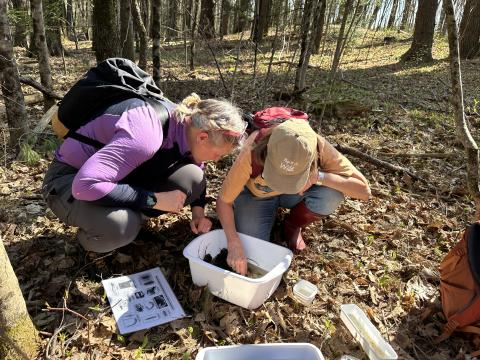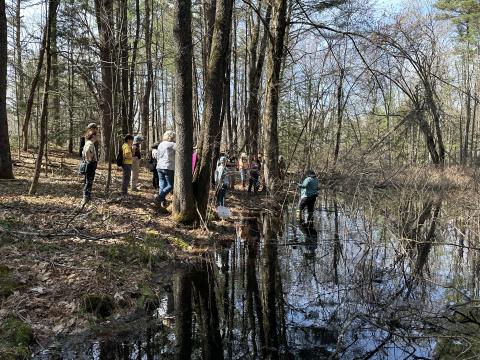Best Practices for Sharing Vernal Pools with Your Community
Early spring brings warmer temperatures, rainy weather, greening grass, blooming flowers, and vernal pools - one of my favorite harbingers of the changing season! Vernal pools are small wetlands that dry up every year, or every couple of years. They are important habitats for a variety of wildlife species in New Hampshire, and are bustling with activity in springtime.
Vernal pools provide critical breeding habitat to a suite of species – wood frogs, spotted salamanders, blue-spotted salamanders, Jefferson’s salamanders, and fairy shrimp. In addition to these amphibians and crustacean that require vernal pools, these small wetlands also attract a wide range of other wildlife – aquatic macroinvertebrates (large insect larvae that live in water), snakes, turtles, raccoons, and even owls – that take advantage of the abundant food source vernal pools provide.

Workshop participants explore some of the incredible discoveries made at a local vernal pool.
These unique habitats are especially fun to explore in the spring. It’s can be easy to see frog and salamander egg masses from the pool edges, and even hear wood frogs calling with their unique quacking call. Hosting a vernal pool walk on town lands can be a great way to engage your community and get people excited about these special and important habitats. It’s important to balance the benefits and potential negative impacts of sharing these special places. Here are some best practices for sharing vernal pools with your community:
Minimize Disturbance

Having only one person enter the water while exploring a vernal pool helps to minimize disturbance.
- Try to access the pool from the edge as much as possible.
- If you need to enter the pool, only have one person enter and try to minimize time and disturbance to the pool.
- Visiting earlier in the season (Mid-April to Early May) helps minimize impacts.
- Please keep dogs at home!
Handle With Care
- Clean hands – never handle egg masses or amphibians if you have lotion, sunscreen, bug spray, or hand sanitizer on your hands.
- Be gentle when handling egg masses and amphibians.
- When you are done, gently release critters and egg masses back into the pool.
Clean Your Gear
- Amphibians are vulnerable to viruses, fungi, and other diseases, which can spread from pool to pool on your field gear.
- When traveling from one cluster of vernal pools to another, be sure to remove mud, algae, and vegetation from your field gear.
- Disinfect field gear with a 4% bleach solution and allow to air dry at the end of the day.
Share with Others!
Be sure to share these best practices with others to help them minimize impacts if they visit vernal pools in the future.

Here are some additional resources to learn more about vernal pools:
Vernal Pool Habitat Stewardship Brochure
Harris Center for Conservation Education – Vernal Pool Project
NHFG Vernal Pool Documentation Manual


